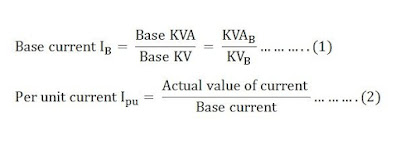Per unit system is a method used in Electrical Engineering for the analysis to express the voltage, current, kVA and impedance in per unit of base or reference values of these quantity.
For illustrating the p.u system, we take single phase two winding Transformer for example.
For High Voltage Side, first of all we need to select base values for calculating the p.u value.
p.u value of reH (Equivalent Resistance reffered to HV side) = Actual value of reH / ZBH
Similarly for LV side of Transformer,
If we choose Rated LV voltage and Current as the Base value, then
Base value of Impedance ZBL= Base Value of Voltage/Base Value of Current
= VBL/IBL
= VBLxVBL/VBLxIBL
= (VBL)2/ Rated kVA
= (kVBL)2/ Rated MVA
Now,
p.u value of rated voltage on HV side = VBH/VBH = 1
p.u value of rated current on HV side = IBH/IBH = 1
Thus we see that p.u value of rated quantities is 1 if we chose rated quantities as the base or reference value. It shall also be noted that p.u value is a dimensionless quantity.
Another important feature of per unit system is that, for Transformer, the p.u value in HV side becomes equal to the p.u value in LV side. (How?)
Let ZeL = Equivalent Impedance when referred to LV side
ZeH = Equivalent Impedance when referred to LV side
So,
p.u Impedance referred to LV side = ZeL/ZBL
Now,
p.u Impedance referred to HV side = ZeH/ZBH
But, ZeH = ZeL(NH/NL)2
Therefore,
p.u Impedance referred to HV side = ZeL[(NH/NL)2] / ZBH
= ZeL/ [ZBH / (NL/NH)2]
= ZeL / ZBL
Thus from the above it is clear that, Transformer equivalent parameters in p.u system are equal in HV as well as LV sides.
Why do we use Per Unit System?
There are several reasons for using a Per Unit System. Some of them are mentioned below:
- Similar apparatus like generators, transformers, transmission lines etc. will have similar per unit impedances and losses expressed on their own rating, regardless of their absolute size. Because of this, per unit data can be checked rapidly for gross errors. A per unit value out of normal range is worth looking into for potential errors.
- Manufacturers usually specify the impedance of apparatus in per unit values.
- Use of the constant is reduced in three phase calculations.
- Per unit quantities are the same on either side of a transformer, independent of voltage level.
- By normalizing quantities to a common base, both hand and automatic calculations are simplified.
- It improves numerical stability of automatic calculation methods.
- Per unit data representation yields important information about relative magnitudes.

Does the secondary wiring impedance of paralleled transformers have any impact in the operation? I am considering placing in parallel operation two 2500 KVA Pad Mounted units which are identical. However, the routing for the secondary wiring will have slightly different lengths (in the order of 20%)
Yes, it will have. However, a little difference between them will not create a problem. Kindly take initial data after operating the units to ensure satisfactory operation.